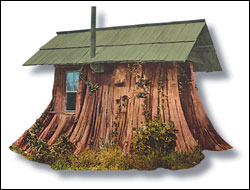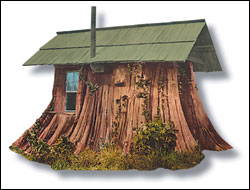This November was April for monorails—the cruelest month. On Nov. 8, Seattle voters euthanized the bungled Green Line, ending the rise-above-it-all dreams of a new generation of monomaniacs. Then, on Nov. 26, the venerable—and sometimes venerated—historic Seattle Center Alweg monorail trains crashed, a seemingly impossible feat given that they run on separate tracks.
The problem appears to be operator error. The folks who run the Seattle Center monorail have known for 17 years of a design flaw that put the two tracks too close together when a stretch was rebuilt in the late 1980s to accommodate the Westlake Mall shopping center. I know, I know, it’s hard to believe that any project in Seattle would compromise its integrity to cater to commercial interests, but there you are.
The monorail’s operators have successfully worked with the flaw for nearly half of the monorail’s life (it’s been running since the 1962 Seattle World’s Fair) by making sure the trains never passed each other on the narrowed stretch near Westlake. Until now.
After this latest accident, some of the monorail’s weaknesses have become a hot topic. While inspections of current damage continue, it turns out that Seattle Monorail Services, the private company that runs the line, is suing its previous insurance company over an earlier incident—the 2004 mechanical failure that resulted in an onboard fire and shut the system down for many months. That breakdown cost the operators more than $4 million in repairs and lost revenue, according to insurance claims. Seattle Weekly‘s Rick Anderson has the details of this little-known lawsuit.
Two accidents—both requiring evacuations— a design flaw, and an aging infrastructure have raised concerns.
For some, the latest crack-up is the final straw. Seattle Times columnist Nicole Brodeur became unhinged at the menace hanging over our heads. In a recent column, she described the fortysomething monorail as “decrepit” and worthy of having life support pulled. “Instead of putting more money into resuscitating the monorail,” she wrote, “the city should expand the streetcar line,” by which she means new streetcars that South Lake Union property owner Paul Allen and developers are getting in that part of town.
Longtime anti–Green Line activist Geof Logan fired off a letter to the Seattle City Council questioning the monorail’s “costly pattern . . . of breakdowns,” saying the train has “clearly exceeded its optimal lifespan.” His main concern is that the city will throw money at the monorail based on sentimentality instead of a hard-nosed look at the future. One of Logan’s fears appears to be that the Green Line monomaniacs might begin to lobby for upgrades and expansion of the Seattle Center line as a way to get a citywide system back on track.
Ironically, it is the death of the proposed Green Line from Ballard to West Seattle that has given a new lease on life to the Seattle Center monorail, which would have been disassembled and replaced with completion of the new system. Seattle’s love for the old monorail was used by Green Line backers to get support for their project, which they sold as an expansion of the original. But the city’s love was conditional. Seattle was willing to dispose of the older icon if, in return, it got a shiny new system. Now that it turns out we can’t afford the new model, the Alweg continues in the role of providing rapid transportation between Seattle Center and the downtown retail core for 2.5 million passengers a year.
But can we afford even that?
Seattle Monorail Services (SMS) partner Stuart Rolfe is adamant that we can. What does he say to suggestions that we tear down the Alweg? “It’s completely asinine.”
Rolfe argues that the city isn’t being stuck with repair bills—SMS is covered by insurance, and the profit the system generates for the operator and the city, which amounts to about $800,000 per year, is divided equally.
“They’re not making sense,” Rolfe says of critics. “It’s an asset of tremendous value to the city, one of the few transit systems that makes money.” He points out that despite the two recent accidents, there’s been no death or major injury on the system, something virtually no other transit system can claim. Seattle Monorail Services can make safety improvements to the line—perhaps even install a kind of fail-safe system that would prevent future collisions along the too-close sections of parallel track. Even without that, they’ve moved millions of passengers on tens of thousands of trips over four decades without many incidents.
As to the general condition of the trains, Seattle Center spokesperson Perry Cooper claims that up to the time of the latest accident, they were in the best condition ever. After the 2004 fire, the trains were significantly upgraded and made safer, at substantial cost.
Someday, we might be asked to invest more in the line, especially now that we know it’s going to be the city’s only monorail. Logan’s right that we have to ask tough questions, but the starting assumption should be that preserving the monorail is a priority, not a burden. It’s an important landmark, part of the civic ecosystem that includes the Space Needle and Seattle Center. It’s not a derelict or a relic. It continues to serve a real public service, and it mostly pays its own way.
There aren’t a lot of landmarks that can claim that.







